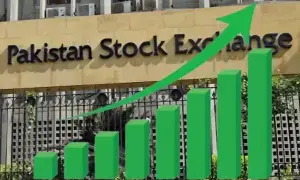Global markets tumble as rising tariff tensions weigh on sentiment, oil prices plunge amid recession fears
Major stock indexes across Asia experienced significant declines on Monday, pressured by escalating trade tensions and the impact of U.S. tariffs on markets. Oil prices also fell sharply, with Brent crude dropping by $1.35 to $64.23 per barrel and U.S. crude declining $1.395 to $60.60 per barrel.
These developments heightened investors’ concerns about a potential recession in the wake of mounting tariff woes.
Futures markets reacted swiftly, pricing in nearly five quarter-point cuts in U.S. rates for the year, which led to a sharp drop in Treasury yields and weakened the dollar.
In Pakistan Stock Exchange (PSX) on Monday, with the benchmark KSE-100 Index plunging by over 3,000 points in early trading. By 9:35am, the index was recorded at 115,623.88, reflecting a loss of 3,167.78 points, or 2.67%.
The decline was marked by widespread selling across major sectors, including cement, commercial banks, oil and gas exploration companies, oil marketing companies (OMCs), refineries, and power generation.
Prominent stocks that significantly impact the index, including HUBCO, ARL, MARI, OGDC, PPL, POL, PSO, SNGPL, SSGC, and HBL, all traded in negative territory. “The Pakistani market is down 3,000 points following the global market crash,” remarked Mohammed Sohail, CEO of Topline Securities.
This downturn followed President Donald Trump’s remarks indicating that investors would have to “take their medicine” and that he would not negotiate with China until the U.S. trade deficit was addressed. In response, Beijing stated that the markets had signaled their stance on retaliation.
A senior FX analyst at ITC Markets in Sydney, Sean Callow, remarked, “The only real circuit breaker is President Trump’s iPhone, and he is showing little sign that the market selloff is bothering him enough to reconsider a policy stance he has maintained for years.”
Wall Street’s substantial losses, amounting to trillions of dollars, had led investors to hope that Trump would reconsider his approach. Bruce Kasman, head of economics at JPMorgan, highlighted the disruptive potential of U.S. trade policies, asserting that continued pressure could push both the U.S. and global economies into recession, assigning a 60% risk of such an outcome.
In volatile trading, S&P 500 futures fell by 3.1%, while Nasdaq futures plummeted 4.0%, compounding last week’s nearly $6 trillion market losses. The negative sentiment also spread to European markets, with EUROSTOXX 50 futures dropping 3.0%, FTSE futures declining 2.7%, and DAX futures falling by 3.5%.
In Asia, Japan’s Nikkei index sank 6%, hitting lows not seen since late 2023, while South Korea’s market declined by 5%. The MSCI index of Asia-Pacific shares outside Japan dropped 3.6%, and Chinese blue chips decreased by 4.4%, as investors anticipated a potential stimulus response from Beijing.
Taiwan’s main index saw a staggering fall of nearly 10% as it reopened after a closure on Thursday and Friday, prompting policymakers to act against short selling.
The gloomy outlook for global growth significantly pressured oil prices, which continued to decline following sharp losses last week. The flight to safe havens resulted in a decrease in 10-year Treasury yields, down 8 basis points to 3.916%, while Fed fund futures indicated a likelihood of an additional quarter-point cut this year.
Market sentiment shifted to suggest a 56% chance of a Fed cut as soon as May, despite Fed Chair Jerome Powell indicating no urgency on rate adjustments. The dollar dipped further by 0.4% against the safe-haven Japanese yen and 0.6% against the Swiss franc, while the trade-sensitive Australian dollar fell by 0.4%.
Speculation surrounding a looming recession led investors to believe it would overshadow potential inflation rises due to tariffs. U.S. consumer price reports are expected to show a 0.3% rise for March, but analysts foresee tariffs raising prices significantly for various goods, including food and vehicles.
As earnings season approaches, analysts at Goldman Sachs projected that fewer companies than usual would offer forward guidance, warning that many would face pressure to either hike prices or accept shrinking profit margins due to rising tariff rates.
This could lead to negative revisions in profit margin estimates in upcoming quarters.
Even gold prices fell by 0.3% to $3,026 an ounce amid the selloff.
In the oil market, prices plummeted over 3% on Monday amid escalating trade tensions between the U.S. and China, raising concerns about a recession that could diminish crude demand.
Brent futures dropped $2.28, or 3.5%, to $63.30 a barrel, and U.S. West Texas Intermediate crude futures fell $2.20, or 3.6%, to $59.79, marking their lowest levels since April 2021.
Concerns that tariffs would weaken the global economy have been the primary driver behind the decline, according to commodity analysts. Additionally, a planned production increase by OPEC+ is contributing to the selling pressure, with experts noting that retaliatory tariffs from countries beyond China will be crucial to monitor.
Read more
Asian stock markets plummet as US tariffs spark trade war fears
Pakistani rupee weakens against US dollar amid global market turbulence
China’s recent decision to impose an additional 34% tariff on U.S. goods has intensified fears of a global trade war, sparking concerns over the potential for an economic recession.
While exemptions were granted for oil, gas, and refined product imports from Trump’s new tariffs, the broader economic implications could lead to inflationary pressures, slow growth, and exacerbated trade disputes, all weighing heavily on oil prices.
For the latest news, follow us on Twitter @Aaj_Urdu. We are also on Facebook, Instagram and YouTube.





















Comments are closed on this story.